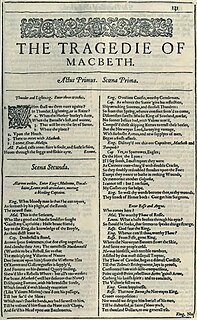
Macbeth is a tragedy by William Shakespeare. It is thought to have been first performed in 1606. It dramatises the damaging physical and psychological effects of political ambition on those who seek power. Of all the plays that Shakespeare wrote during the reign of James I, Macbeth most clearly reflects his relationship with King James, patron of Shakespeare's acting company. It was first published in the Folio of 1623, possibly from a prompt book, and is Shakespeare's shortest tragedy.

Thomas Middleton was an English Jacobean playwright and poet. He, with John Fletcher and Ben Jonson, was among the most successful and prolific of playwrights at work in the Jacobean period, and among the few to gain equal success in comedy and tragedy. He was also a prolific writer of masques and pageants.
The History of Cardenio, often referred to as simply Cardenio, is a lost play, known to have been performed by the King's Men, a London theatre company, in 1613. The play is attributed to William Shakespeare and John Fletcher in a Stationers' Register entry of 1653. The content of the play is not known, but it was likely to have been based on an episode in Miguel de Cervantes's Don Quixote involving the character Cardenio, a young man who has been driven mad and lives in the Sierra Morena. Thomas Shelton's translation of the First Part of Don Quixote was published in 1612 and would thus have been available to the presumed authors of the play.

The revenge tragedy, or revenge play, is a dramatic genre in which the protagonist seeks revenge for an imagined or actual injury. The term revenge tragedy was first introduced in 1900 by A. H. Thorndike to label a class of plays written in the late Elizabethan and early Jacobean eras.

A Yorkshire Tragedy is an early Jacobean era stage play, a domestic tragedy printed in 1608. The play was originally assigned to William Shakespeare, though the modern critical consensus rejects this attribution, favouring Thomas Middleton.
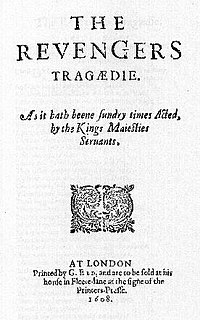
The Revenger's Tragedy is an English-language Jacobean revenge tragedy which was performed in 1606, and published in 1607 by George Eld. It was long attributed to Cyril Tourneur, but "The consensus candidate for authorship of The Revenger’s Tragedy at present is Thomas Middleton, although this is a knotty issue that is far from settled."
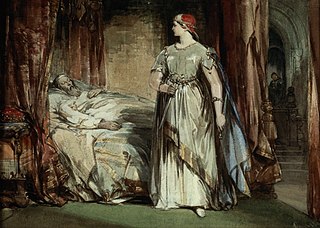
Lady Macbeth is a leading character in William Shakespeare's tragedy Macbeth. As the wife of the play's tragic hero, Macbeth, Lady Macbeth goads her husband into committing regicide, after which she becomes queen of Scotland. After Macbeth becomes a murderous tyrant, she is driven to madness by guilt over their crimes, and commits suicide offstage.

John Fletcher (1579–1625) was a Jacobean playwright. Following William Shakespeare as house playwright for the King's Men, he was among the most prolific and influential dramatists of his day; during his lifetime and in the early Restoration, his fame rivalled Shakespeare's. He collaborated on writing plays with Francis Beaumont, and also with Shakespeare on three plays.
The Witch is a Jacobean play, a tragicomedy written by Thomas Middleton. The play was acted by the King's Men at the Blackfriars Theatre. It is thought to have been written between 1613 and 1616; it was not printed in its own era, and existed only in manuscript until it was published by Isaac Reed in 1778.
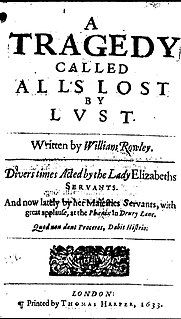
All's Lost by Lust is a Jacobean tragedy by William Rowley. A "tragedy of remarkable frankness and effectiveness," "crude and fierce," it was written between 1618 and 1620.
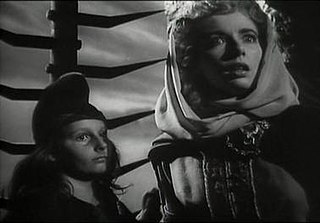
Lady Macduff is a character in William Shakespeare's Macbeth. She is married to Lord Macduff, the Thane of Fife. Her appearance in the play is brief: she and her son are introduced in Act IV Scene II, a climactic scene that ends with both of them being murdered on Macbeth's orders. Though Lady Macduff's appearance is limited to this scene, her role in the play is quite significant. Later playwrights, William Davenant especially, expanded her role in adaptation and in performance.

The Puritan, or the Widow of Watling Street, also known as The Puritan Widow, is an anonymous Jacobean stage comedy, first published in 1607. It is often attributed to Thomas Middleton, but also belongs to the Shakespeare Apocrypha due to its title page attribution to "W.S.".

John Warburton (1682–1759) was an antiquarian, cartographer, and Somerset Herald of Arms in Ordinary at the College of Arms in the early 18th century.
Anything for a Quiet Life is a Jacobean stage play, a city comedy written by Thomas Middleton and John Webster. Topical allusions suggest the play was written most likely in 1621.
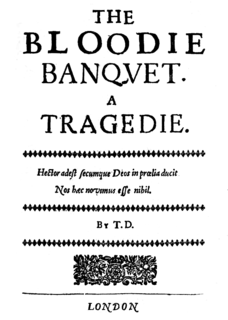
The Bloody Banquet is an early 17th-century play, a revenge tragedy of uncertain date and authorship, attributed on its title page only to "T.D." It has attracted a substantial body of critical and scholarly commentary, chiefly for the challenging authorship problem it presents. It has been attributed to a collaboration between Thomas Dekker and Thomas Middleton.
The Duke of Milan is a Jacobean era stage play, a tragedy written by Philip Massinger. First published in 1623, the play is generally considered among the author's finest achievements in drama.
The Woman's Prize, or the Tamer Tamed is a Jacobean comedy written by John Fletcher. It was first published in the first Beaumont and Fletcher folio of 1647, though it was written several decades earlier. There is no doubt that the play is the work of Fletcher alone; his highly distinctive and characteristic pattern of linguistic preferences is continuous through the text.

Women Beware Women is a Jacobean tragedy written by Thomas Middleton, and first published in 1657.

A Fair Quarrel is a Jacobean tragicomedy, a collaboration between Thomas Middleton and William Rowley that was first published in 1617.
William Shakespeare's play Romeo and Juliet contains a relatively distinctive cast of characters. In addition to the play's eponymous protagonists, Romeo Montague and Juliet Capulet, the play, which is set in Verona, Italy, contains roles for members of their respective families and households; Prince Escalus, the city's ruler, and his kinsman, Count Paris; and various unaffiliated characters such as Friar Laurence and the Chorus. In addition the play contains two ghost characters and an unseen character (Rosaline).

















